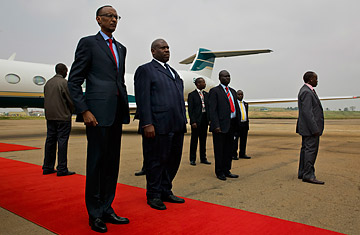
Uganda, Entebbe, 2012. President of the Republic of Rwanda Paul Kagame arrives in Uganda to take part in the a Great Lakes summit, joins the host President Yoweri Museveni, DRC's Joseph Kabila and other East African Head of State's, to discuss the insecuritues in Eastern Congo.
(2 of 5)
Kagame's life, like his country's, is a story of survival. He was born in a hillside village called Tambwe in southern Rwanda in 1957. His family was ethnically Tutsi, the minority group politically favored over the majority Hutu by Rwanda's Belgian overlords. The independence movement was sweeping Africa, and in Rwanda, Hutu began violently asserting their claim to power. In 1959 mobs butchered tens of thousands of Tutsi. Kagame's family fled, settling in the Gahunge refugee camp in southwest Uganda in 1962, the year the Belgians handed power to a Hutu regime. Kagame remembers, as a boy, asking his parents why they were homeless. "I thought they must have done something," he says. His parents told him about the massacres, and the seed of rebellion was planted. "It's on that basis that we, young people, thought of organizing. Even if it meant fighting, we would do that."
Kagame's best friend was Fred Rwigema. Successful revolutionaries had experience, the pair decided. In 1980, age 22, Kagame and Rwigema were among the original 27 recruits to Yoweri Museveni's guerrilla army, which opposed the brutal regime of then President Milton Obote. After six years of bush fighting, and with a force that had grown to tens of thousands, Museveni took Uganda's capital, Kampala, with Kagame and Rwigema at his side. Kagame, an introvert, became Museveni's head of military intelligence. Rwigema, an extrovert, was appointed Deputy Minister of Defense. By day, the pair defended Uganda. At night, they plotted revolution in Rwanda.
Tito Rutaremara first met Kagame and Rwigema in Kampala in 1987 soon after the three men formed the Rwandan Patriotic Front (RPF). Today a portly, gray-haired Senator in Rwanda's Parliament, Rutaremara was then a wild-haired dissident in London. On his visits to Kampala, the trio would discuss rebellion. Rutaremara argued there were lessons to be learned from previous struggles: foreign backing could turn out to be a yoke; Western ideology made a revolution inflexible and exclusive; and strong self-criticism was needed to avoid corruption, factionalism and authoritarianism. The RPF, the three men concluded, must be self-reliant, inclusive — incorporating fighters, civilians, Hutu and Tutsi alike — and internally democratic. Above all, it should not slavishly import Western ideas. "Everything is contextual," says Kagame. "What was happening in America 100 years ago is not happening now. You can't expect things to happen the same way there as here."
Once launched on the ground in Rwanda, their revolution was almost over as soon as it began. In early 1990, Kagame accepted a U.S. offer of several months' military training at Fort Leavenworth in Kansas. The impetuous Rwigema decided not wait for his friend. On Oct. 1, he crossed from Uganda into Rwanda at the head of 2,000 men. He was killed within hours. When Kagame caught up with the RPF in northern Rwanda days later, it was disintegrating. Swallowing his grief, he marched his forces high up the Virunga volcanoes, home to mountain gorillas, organized food and ammunition, and drilled discipline back into the ranks. "He was the right person at the right time to save the struggle," says Rutaremara.
By 1991, a remade RPF was taking territory. By 1992, it had beaten back a national army supported by 1,000 French paratroopers almost to Kigali. Peace talks were under way by April 1994. But on April 6, a plane carrying the Rwandan and Burundian Presidents, both Hutu, was shot down over Kigali. Disputes over who fired the fatal missile continue to this day. But the double assassination acted as a signal to Hutu government soldiers and their allied militias — the Interahamwe — to start the apocalypse that, it soon became apparent, they had been preparing for months.
Around 800,000 Tutsi and suspected Hutu sympathizers died in 100 days. No one can be sure of the exact number — even today, signs marking massacre sites in Rwanda read: "+/ — 5,000 dead." A frequent genocidaire tactic was to urge Tutsi to seek shelter in churches, throw grenades through the windows, then wade through the pews with machetes. Kagame stopped visiting the massacre sites after a while. "He wanted to avoid his judgment being influenced," says Rutaremara. "If you saw those thousands of bodies, you could only think about revenge."
By mid-July, Kagame had taken the country and pushed the genocidaires into eastern Congo. In 2007, Kagame told me he was still struggling with what he saw. "Fathers were killing their own children because [they] resembled their wife, who was a Tutsi," he said. "How do you explain that?" Human Rights Watch would later claim the RPF did carry out its own reprisals, killing 25,000 civilians. Kagame says the real story lies in how many people the RPF didn't kill. "We had to battle extreme anger among our own men. So many had lost their families, and they had guns in their hands. Whole villages could have been wiped out. But we did not allow it."
After watching the world fail to intervene in the genocide, Kagame then saw it smother the killers with aid in neighboring Congo while also neglecting to bring them to account, despite deploying the world's biggest U.N. peacekeeping force.
